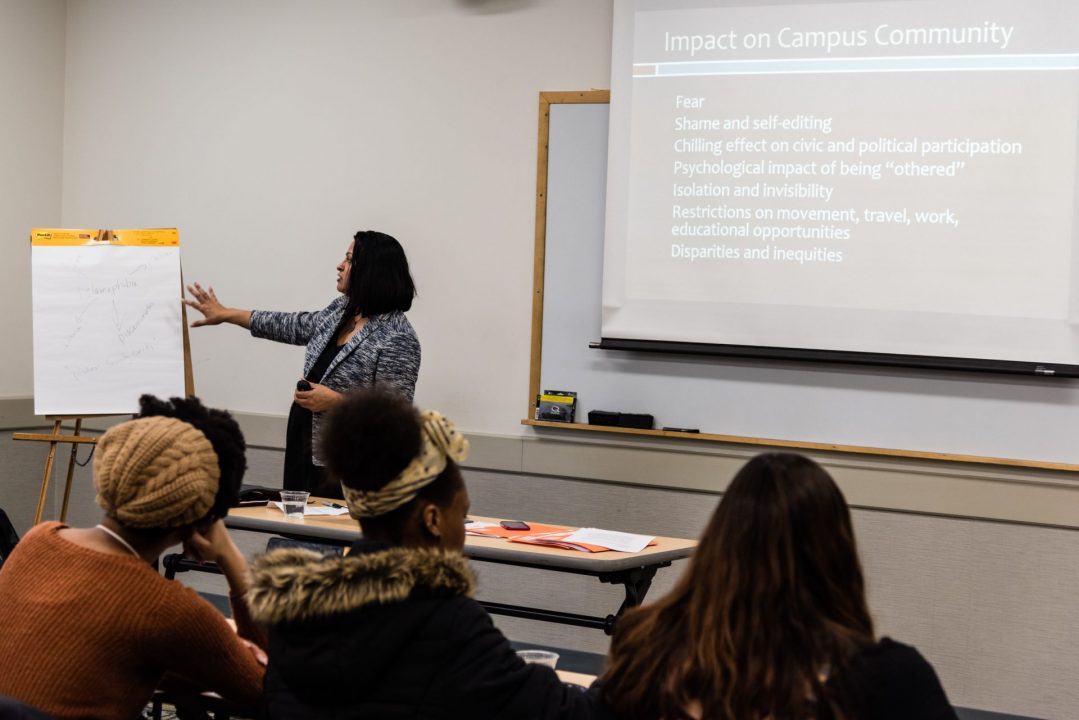The racial geography of the United States of America is shifting. According to the Migration Policy Institute, more immigrants are on the way. The majority come from Asian, Latin-American and African countries.
South Asian-American racial justice advocate Deepa Iyer studies growing racial anxiety in the United States. “As minority populations grow, they feel more included. Yet, white populations fear how immigration could affect America,” she says.
Iyer uses kindergartners to provide a glimpse into the future of America’s racial climate. “[In] 2014, [we] saw more children of color in kindergarten compared to whites for the first time,” says Iyer. “By 2040, [sic] people of color will become the majority of the U.S. population.”
The term racial anxiety describes uncertainty and stress. Students in the workshop learned how it manifests itself through hate crimes, discrimination and vandalism.
The workshop focused on Islamophobia and acts of hatred toward Muslims and those perceived as Muslim. Iyer says, “In 2012, there was a shooting at a Wisconsin Sikh temple resulting in six dead and four injured. The shooter said, ‘I don’t like these people because they look Muslim.’”
Islamophobia is a form of discrimination often based on the premise that, “anyone who is Muslim or perceived Muslim is suspected as a national security threat.” Iyer says, “it affects more than Muslim communities. It also affects people who look South Asian.”
Iyer discusses the impacts of Islamophobia. “There is shame and self-editing. The minority hides their culture because they don’t want to appear threatening to others,” she says.
Freshman biochemistry major Mara Kushelman speaks about her experience with Islamophobia in Russia. “[When I lived there], the government was positive toward Muslims so they didn’t need to hide. In America, it’s different,” she said. Newsweek, however, reported in 2016 that the Russian government began pressuring Muslim communities to leave the country because of alleged concerns about extremism and terrorists.
Iyer explained that racial anxiety plays a role in Islamophobia, relaying that “there are white national groups as well as anti-Muslim, anti-immigrant and anti-black communities.” She mentioned the recent shooting in Parkland. Suspected shooter Nikolas Cruz might have had connections with a white nationalist group.
“When the offender is white,” Iyer says, “there are double standards. The [government] changes their approach depending on the race.”
In 2015, a student named Ahmed Mohamed brought his science project to school. Teachers assumed it was a bomb and called the police to arrest him. “They’re worried,” Kushelman says. “This fear came from stereotyping. There shouldn’t be any discrimination because you are different.”
Some people may find racism a difficult topic to approach. Iyer believes that the first step is to understand it. “We are responsible to understand the ways in which racism plays out,” Iyer says. “We have to open up about it rather than shy away from it.”
Students learned about “race plus discrimination” as a way to acknowledge racism. Iyer explains that everyone carries identities other than their race. “There is a twitter that talks about being Black and Muslim. These people experience two levels of discrimination.”
Iyer encourages students to intervene and question racism. “We build America’s culture. The beauty of America is that it’s an experiment. It is messy. It is wrong. It makes mistakes. But we can shift what being an American means,” says Iyer.

